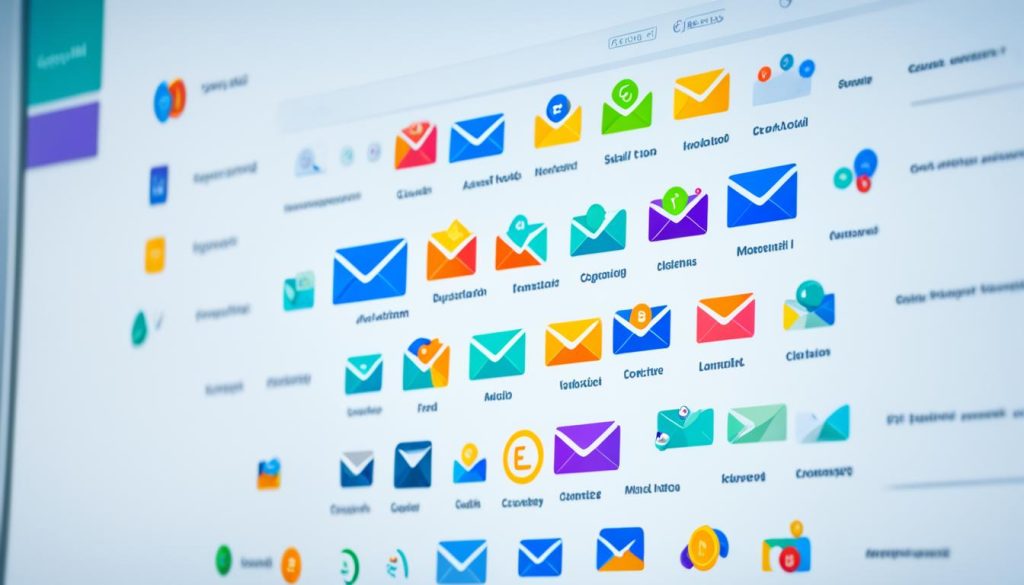Imagine having a direct line to your most engaged customers, ready to receive your latest updates, offers, and content. That’s the power of a well-crafted email list. But did you know that building and maintaining an email list is one of the most cost-effective marketing strategies? It can bring in a potential return of $36 for every $1 spent. That’s a jaw-dropping statistic that shows the immense value of email marketing when done right.
In this comprehensive guide, you’ll learn the secrets to creating and nurturing a thriving email list. We’ll cover everything from the importance of permission-based marketing to strategies for targeting the right audience. By the end, you’ll know how to turn your email list into a powerful asset for your business.
Permission-Based Email Lists: The Foundation of Success
Building a successful email marketing strategy starts with permission-based marketing. This means your list should have people who have said they want to hear from your brand.
Importance of Opt-In and Consent
Getting opt-in consent is a must in many places, not just a good idea. It means your contacts have chosen to get your emails. This leads to better engagement and results. Spam is a major no-no, so keeping your list clean is key to a good reputation.
Avoiding Purchased or Rented Lists
It might seem tempting to buy or rent a list quickly, but don’t do it. These lists often have bad emails that can hurt your reputation. Instead, grow your list the right way with good opt-in strategies and content that draws people in.
| Purchased or Rented Lists | Permission-Based Lists |
|---|---|
|
|
Choosing permission-based marketing and avoiding bought or rented lists sets you up for success. This method is legal and builds a quality list that boosts your business’s results.
Accurate and Up-to-Date Email Addresses
Keeping your email list accurate is key for good email marketing. It’s important to clean your list often. This helps make sure your messages get to the right people and don’t get lost.
Data Hygiene Practices
To keep your email data right and current, try these steps:
- Use double opt-in forms to confirm email addresses and get clear consent from subscribers.
- Use email verification tools to check if email addresses are real before adding them.
- Check your email list often and take out any emails that don’t work or bounce back.
- Ask subscribers to update their email info and preferences when needed.
Managing Bounced Emails
Bounced emails happen when emails can’t be sent. This can hurt your sender reputation and how well emails get delivered. Here’s how to handle bounced emails:
- Remove hard bounces (permanent failures) from your list.
- Look into soft bounces (temporary failures) and decide what to do next, like trying again or removing the email.
- Use bounce management tools or your email service provider’s features to handle bounced emails automatically.
- Keep an eye on your bounce rate and work on making your email list better over time.
By following these email list maintenance tips, you can make sure your list is correct, current, and works well for your email marketing.
Building and maintaining an email list
Creating and keeping a strong email list is key to great email marketing. It’s important to have good strategies for getting new subscribers and growing your list. By using different tactics, you can keep adding to your email list and build strong connections with your contacts.
Offering something valuable to potential subscribers is a big part of building an email list. This could be special content, discounts, or offers that make people want to give you their email. Also, making your website easy to use with clear calls-to-actions and forms can help a lot with email list building and subscriber acquisition.
Keeping your email list in good shape is just as crucial. Regular checks and managing bounced emails keep your list clean and current. Sending interesting, personalized emails and using automation can keep your subscribers happy and engaged, helping your list grow over time.
With a solid plan for building and maintaining your email list, you can create a valuable resource for your marketing. Focusing on growing your list, keeping your data clean, and engaging with subscribers will make your email list a key tool for success.
Targeting the Right Audience
Building a strong email list is not just about how many people you have. It’s also about the quality of those people. They should really care about what you offer. And they should match the kind of people you want to reach with your emails. Knowing who your ideal audience is and what they like is key to getting them to open and engage with your emails.
Understanding Your Target Market
Do your homework to learn about your audience. Find out what they like, what problems they face, and what they’re interested in. This helps you make content and offers that speak to them. Think about things like their age, gender, where they live, how much they make, what they like, and how they use the internet. This will give you a clear picture of who you want to reach.
Segmentation and Personalization
- Break your email list into groups based on things like age, interests, what they’ve bought before, or how much they interact with your emails. This way, you can send emails that really matter to each person.
- It’s not just about using someone’s name in your email. Make sure the content, deals, and messages you send are right for each group. This makes your emails more useful and interesting.
- Keep an eye on how well your groups and personal touches work. Make sure you’re hitting the mark with the right target audience and content.
By really getting to know your target audience and using audience segmentation and personalization, you can build an email list that’s active and brings real results for your business.

Engaging and Retaining Subscribers
Building a successful email list is more than just getting new subscribers. It’s also about keeping your current ones interested and loyal. The best lists have subscribers who really interact with the sender. They open, click, and reply to emails often. These people are more likely to buy, share your content, and be valuable over time.
Creating Valuable Content
It’s important to make content that keeps your subscribers hooked. Your email strategy should aim to give your audience useful info, education, or fun. This could be industry tips, special deals, or entertaining stuff. By making content that hits the mark, you build a strong bond with your subscribers. This makes them more likely to keep reading your emails.
Email Automation and Workflows
Email automation and smart workflows can send the right content at the right time. This boosts email engagement and subscriber retention. By automating your emails, you can send personalized messages based on what subscribers do. This could be welcome messages, reminders about items left in cart, or content based on their interests. Using email automation and email marketing workflows helps make sure your subscribers get content they care about. This builds a stronger connection and keeps them subscribed.
- Craft a email content strategy that provides value to your subscribers
- Implement email automation and workflows to deliver the right content at the right time
- Focus on subscriber engagement and retention to build a loyal audience
Measuring and Optimizing Email Performance
It’s key to track email marketing metrics to see how well your email campaigns do. By looking at open rates, click-through rates, conversion rates, and unsubscribe rates, you can make your emails better. This helps you improve your content, subject lines, and strategies for better results.
Key Email Marketing Metrics
To see how well your email marketing works, focus on these important metrics:
- Open Rate – the percentage of people who opened your email
- Click-through Rate (CTR) – the percentage of people who clicked on a link in your email
- Conversion Rate – the percentage of people who did what you wanted them to, like buying something or signing up
- Unsubscribe Rate – the percentage of people who stopped getting your emails
A/B Testing and Continuous Improvement
Doing A/B tests on things like subject lines, content, and CTAs can show you what works best. By testing and looking at the results, you can make data-driven decisions. This helps you improve your email marketing program over time.

Email optimization is a constant process. By always checking and analyzing your email performance, you can make smart choices. This helps you continuously improve your email marketing. And it leads to better results for your business.
Leveraging Pop-ups and CTAs for List Growth
Expanding your email list is key for lead generation and email marketing success. Using pop-ups and personalized calls-to-action (CTAs) on your website is a great strategy. Offer visitors something valuable in exchange for their email address to grow your list with engaged contacts.
Pop-ups can be a subtle yet effective way to get new email subscribers. They work best when offering something valuable like a discount, content upgrade, or free trial. The goal is to give visitors a reason to share their email address willingly.
CTAs are also crucial. Place them thoughtfully to encourage visitors to join your email list. Match your CTAs with your content or the buyer’s journey stage for better results. This approach helps grow your email list and generate leads.
Success with pop-ups and CTAs comes from balancing email capture with a good user experience. Don’t be too aggressive or disruptive. Aim for a smooth and valuable interaction with your visitors.
Using pop-ups and CTAs can help you build your email list and get quality leads. Try different offers and placements to see what works best for your audience and goals.
Email List Management Tools and Platforms
Keeping your email list healthy is key to your email marketing success. Luckily, there are many email list management tools and platforms to help. These tools automate and streamline your email list maintenance, email marketing automation, and more. This lets you focus on making your emails engaging and effective.
Email list management software helps keep your list accurate and current. It includes tools like list hygiene to remove bad email addresses and email verification to check new contacts. A clean list means your emails get to the right people, boosting your success.
These tools also offer advanced features for segmenting and personalizing your emails. You can send emails that really speak to your audience, based on what they like and do. This makes your emails more relevant and engaging, leading to better results.
When picking an email list management platform, look for features like list management, automation, analytics, and integration with your marketing tools. The right software can make your email marketing smoother, more effective, and better for your business.
| Email List Management Software | Key Features | Pricing |
|---|---|---|
| Mailchimp |
|
Starting at $9.99/month |
| Constant Contact |
|
Starting at $20/month |
| ActiveCampaign |
|
Starting at $9/month |
Using the right email list management software can make your email marketing better. It helps streamline your process, improve your campaigns, and boost your business results.

Complying with Anti-Spam Laws and Regulations
In the world of email marketing, following anti-spam laws is key. Not following them can lead to big fines, harm your brand, and legal issues. It’s important to know about laws like the CAN-SPAM Act in the United States and the GDPR in the European Union.
To be email marketing compliant, you need to get clear consent from your subscribers. This means everyone on your list must have agreed to receive emails from you. You can do this through a double opt-in or clear consent. It’s also key to respect people’s choices and make it easy for them to unsubscribe.
- Follow CAN-SPAM and GDPR rules for email marketing
- Get clear, permission-based consent from each subscriber
- Make it easy for people to unsubscribe
- Keep your email list clean by removing bad addresses and inactive users
- Know the rules for sending emails worldwide
Putting email marketing compliance first helps you grow a strong, engaged list. It also keeps you out of trouble. This is a big part of managing your email list well.
| Regulation | Key Requirements | Penalties for Non-Compliance |
|---|---|---|
| CAN-SPAM Act (United States) |
|
|
| GDPR (European Union) |
|
|
The Power of Welcome Emails and Nurture Sequences
Your email list is key to your digital marketing. The first email you send to new subscribers sets the stage for future interactions. Welcome emails and nurture sequences are great for onboarding new subscribers. They help build trust and move them towards becoming loyal customers.
Welcome emails are the first thing new subscribers see. They introduce your brand and set expectations. A warm, personalized welcome can make subscribers more likely to engage with your brand in the future.
- Welcome emails usually get more opens and clicks than regular emails.
- They let you share your brand’s story and highlight what makes you special. You can also invite subscribers to check out your website or social media.
- These emails can also offer a special deal to get subscribers more involved.
After the welcome email, a nurture sequence follows. This is a set of automated emails that guide new subscribers through their journey with your brand. These emails can cover topics like:
- Email onboarding: Showing subscribers what you offer and what you’re about.
- Email nurturing: Sharing valuable content to build trust and show you’re an expert in your field.
- Subscriber engagement: Getting subscribers to interact with your brand, share their experiences, or join in on promotions.
Automating this sequence means new subscribers get a consistent, personalized experience. This keeps them engaged and helps them move closer to becoming customers.
| Welcome Emails | Nurture Sequences |
|---|---|
|
|

Using welcome emails and nurture sequences can turn new subscribers into loyal customers. These strategies help them understand your brand and prepare them to take action. They become advocates for your brand.
Encouraging Referrals and Word-of-Mouth
Getting your email subscribers to tell their friends about you can really help your list grow. Offer them something nice for referring others. This way, they’ll share your stuff with their networks, bringing in new, interested people. It’s all about word-of-mouth marketing and can really help you grow your list.
To make a referral program work well, follow these tips:
- Craft Engaging Subject Lines: Make your subject lines interesting to get your subscribers to share your emails with others.
- Segment Your Email List: Find your most loyal subscribers and send them special referral offers and actions.
- Offer Attractive Incentives: Give your subscribers good reasons to share your stuff, like discounts or special content.
- Leverage Social Proof: Show off what happy customers say about you to make new people trust you.
- Automate the Referral Process: Use email automation to make sharing easy for your subscribers.
- Include Clear Calls-to-Action: Make sure your emails have strong calls-to-action that push your subscribers to share your content.
Using these tips, you can really grow your email list, referral programs, and word-of-mouth marketing. This will bring in new, interested subscribers and boost your email marketing success.
Managing Unsubscribes and Re-engagement Campaigns
As an email marketer, it’s key to know not all subscribers will stay engaged. Making the email unsubscribe easy and clear is vital for good email list maintenance. A clear unsubscribe link keeps subscribers happy and avoids spam complaints.
When people unsubscribe, you can try to bring them back with email re-engagement campaigns. Targeted subscriber reactivation campaigns can make your email list hygiene better and boost engagement.
Unsubscribe Process Best Practices
When someone wants to unsubscribe, make it easy for them. Put a clear unsubscribe link in every email. This lets users easily opt-out if they don’t want your emails anymore.
Re-engagement Strategies
For subscribers who are no longer interested, try re-engagement campaigns. Offer special content or discounts, or ask if they still want your emails. Good re-engagement plans can make your email list more active and boost engagement.

| Best Practices for Email Unsubscribes | Strategies for Email Re-engagement |
|---|---|
|
|
Integrating Email Marketing with Other Channels
Successful omnichannel marketing means blending your email marketing with other channels like your website, social media, and ads. This approach helps you reach more people, grow your email list, and give your audience a smooth, personalized experience.
To boost your email marketing, add opt-in forms, pop-ups, and calls-to-action on your website. Offer something valuable in return for email addresses, like exclusive content or discounts.
Use social media to promote your email list and get more subscribers. Share interesting content that makes people want to sign up. Also, consider paid ads to help your email campaigns reach more people.
Make sure your email marketing fits with your content marketing. Share useful content that matches your email messages. This keeps your audience interested and connected to your brand.
By integrating email marketing with other channels, you create a unified experience. This improves customer engagement, grows your audience, and boosts your marketing success.
Email List Segmentation Strategies
Effective email marketing means sending targeted and personalized content to your audience. Segmenting your email list is a key strategy for this. By breaking your list into smaller groups, you can make campaigns that speak directly to your subscribers.
Demographic Segmentation
Use demographic factors like age, gender, location, and job title to segment your list. This way, you can send messages that really speak to each group. It makes your marketing more relevant and appealing.
Behavioral Segmentation
Looking at how your subscribers act can also help segment your list. Track their website visits, what they buy, and how they interact with emails. This lets you see patterns and group your list based on behavior. With this approach, you can send content and offers that match what your audience likes and does, boosting engagement and sales.
Using both demographic and behavioral segments can make your email marketing much more effective. It lets you create a highly personalized and engaging experience for your subscribers.
Email Deliverability and Sender Reputation
Having a strong sender reputation and good email deliverability is key for your email marketing success. Things like list hygiene, subscriber engagement, and following anti-spam laws affect your sender reputation. They also affect how ISPs treat your emails. Using best practices in these areas can make sure your emails get to your subscribers’ inboxes.
Keeping your email list clean is vital for a good sender reputation. Regular cleaning, accurate data, and following anti-spam laws can boost your deliverability. By keeping your lists current and engaging your subscribers, you show ISPs your content is valuable and relevant. This can lift your sender score.
Also, engaging with your email audience is crucial for a strong sender reputation. Making content that connects with your subscribers and using smart email automation can increase engagement. This keeps a good email provider reputation.

